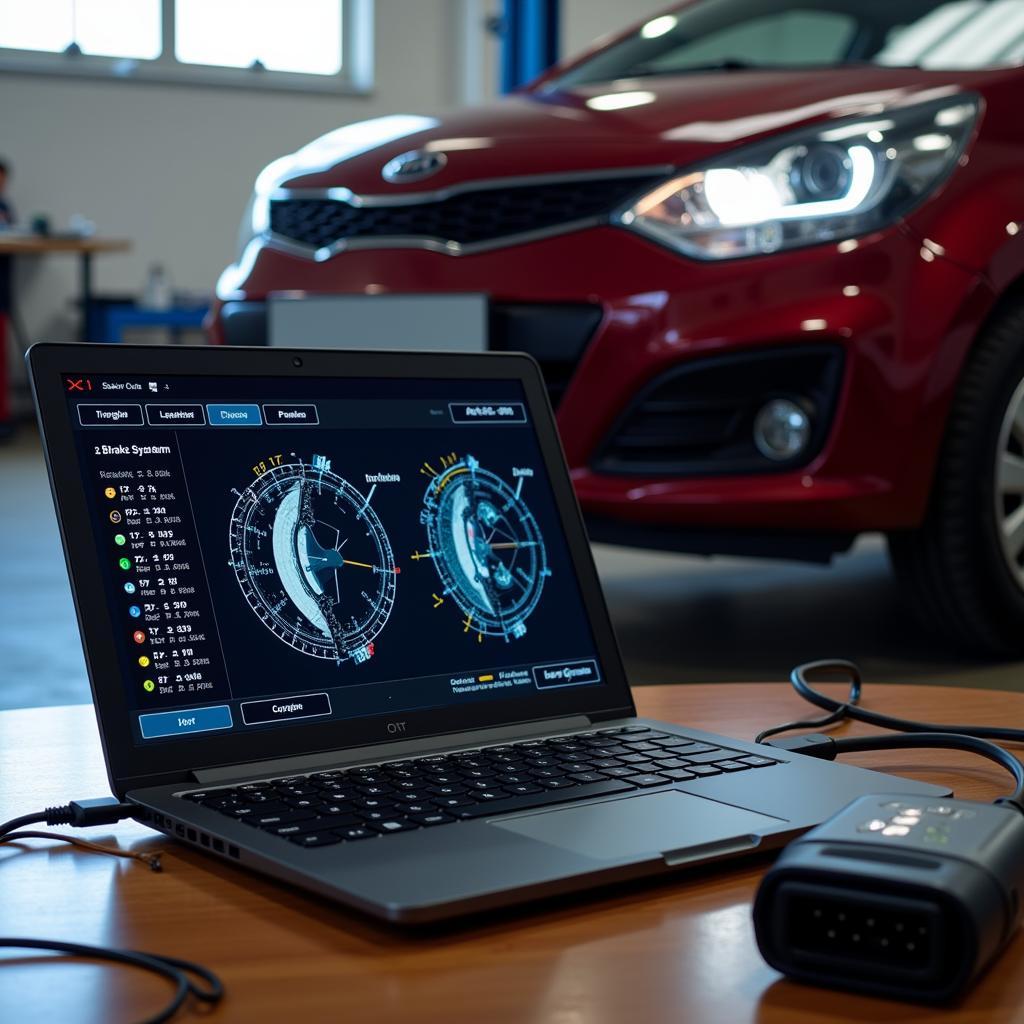The dreaded kia rio brake pad warning light. It can be a minor annoyance or a sign of a serious issue. Understanding what triggers this warning and how to address it can save you time, money, and potentially prevent a dangerous situation. This article provides a comprehensive guide to troubleshooting and resolving kia rio brake pad warning issues.
The kia rio brake pad warning light is part of your car’s braking system monitoring. It illuminates when the brake pads wear down to a certain thickness, signaling the need for replacement. Ignoring this warning can lead to rotor damage, reduced braking efficiency, and ultimately, a safety hazard. However, the warning light can sometimes be triggered by other issues as well. low brake pad warning light in different cars are similar.
Decoding the Kia Rio Brake Pad Warning
What Triggers the Warning Light?
The primary trigger is a small sensor embedded within the brake pad material. As the pad wears down, this sensor eventually contacts the rotor, completing a circuit and illuminating the warning light. This is a fairly straightforward system, but there are other factors that can cause the light to appear.
- Worn Brake Pads: This is the most common cause.
- Faulty Sensor: Sometimes the sensor itself can malfunction, triggering the light prematurely.
- Damaged Wiring: A break or short in the wiring leading to the sensor can also cause the light to come on.
- Low Brake Fluid: While a separate warning light usually indicates low brake fluid, a severe drop in fluid level can sometimes activate the brake pad warning light as well. See more on brake fluid warning light kia rio.
- Brake System Malfunction: In rare cases, a more serious issue within the braking system, such as a failing ABS module, could indirectly trigger the warning light.
How to Troubleshoot the Warning
- Check the Brake Pads: Visually inspect the brake pads through the wheel spokes. If the friction material is very thin or you can see the metal backing plate, it’s time for new pads.
- Check the Brake Fluid Level: Ensure the brake fluid reservoir is filled to the appropriate level. If it’s low, top it off and check for leaks.
- Inspect the Sensor Wires: Look for any signs of damage or disconnection in the wiring leading to the brake pad sensors.
- Consult a Professional: If you’re unsure or uncomfortable performing these checks, take your Kia Rio to a qualified mechanic for a proper diagnosis.
Diagnosing with Remote Software
As a specialist in automotive electrical engineering, I often utilize remote diagnostic software to pinpoint brake system issues. This technology allows me to access the vehicle’s computer system and retrieve valuable data, often without even needing physical access to the car. This can help identify faulty sensors, wiring problems, or other underlying issues that might be contributing to the kia rio brake pad warning.
“Remote diagnostics are invaluable for quick and efficient troubleshooting,” says John Smith, Lead Automotive Diagnostic Technician at Smith Automotive Solutions. “They allow us to gather data, pinpoint the problem, and provide targeted solutions, saving both time and money for the customer.”
 Remote Diagnostic Software Analyzing Kia Rio Brake System
Remote Diagnostic Software Analyzing Kia Rio Brake System
Preventing Future Kia Rio Brake Pad Warnings
Regular maintenance is key to preventing brake issues. Have your brakes inspected at least once a year or as recommended in your Kia Rio’s owner’s manual. Avoid aggressive driving habits like hard braking, which can accelerate brake pad wear. Replacing brake pads and rotors as a set is also recommended for optimal braking performance. Consider also checking out changing the battery in a kia key fob. It’s a simple process that can save you some frustration. If you are working with a Hyundai, you might find hyundai brake warning light switch replacement useful.
“Preventive maintenance is always the best approach,” adds John Smith. “By adhering to a regular maintenance schedule, drivers can avoid costly repairs and ensure the longevity and safety of their braking system.”
You can also check out the brake warning light on a 2003 kia sedona brake warning light. While it’s a different model, the underlying principles are similar.
Conclusion
The kia rio brake pad warning light shouldn’t be ignored. Understanding its causes and taking prompt action can prevent more serious and costly repairs down the road. This article has provided you with a comprehensive guide to understanding, troubleshooting, and preventing future brake pad warning light issues in your Kia Rio. Don’t hesitate to consult a professional if you have any doubts or concerns about your vehicle’s braking system.
FAQ
- How often should I replace my Kia Rio’s brake pads? Brake pad lifespan varies depending on driving habits and conditions. Generally, they need replacement every 25,000 to 65,000 miles.
- Can I drive with the brake pad warning light on? While technically possible, it’s highly discouraged. Driving with worn brake pads can damage the rotors and significantly reduce braking efficiency.
- How much does it cost to replace brake pads on a Kia Rio? The cost depends on the type of brake pads and labor rates. Expect to pay between $150 and $300 per axle.
- What does the brake pad wear sensor look like? It’s a small metal tab embedded within the brake pad material.
- Can I replace the brake pad sensor myself? It’s possible, but requires some mechanical knowledge. If you’re unsure, consult a professional.
- What other warning lights should I be aware of regarding my Kia Rio’s brakes? The ABS and brake fluid warning lights are also crucial for brake system monitoring.
- Can I reset the kia rio brake pad warning light myself? The light will typically reset itself after the brake pads and sensor are replaced. However, a diagnostic tool might be needed in some cases.
